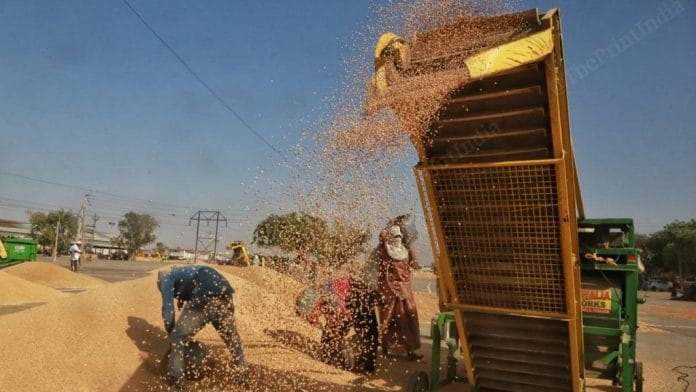New Delhi: The stock of foodgrains in the central pool this year is likely to touch a record high on the back of a bumper cereal harvest and record MSP purchases during the ongoing rabi procurement season (2021-22).
According to data from the Food Corporation of India (FCI), the nodal government agency for foodgrain procurement, the stock in the central pool stood at 830.5 lakh metric tonnes (LMT) as of 2 June. This is only next to the 832 LMT recorded in June 2020, which is the highest ever for India’s buffer stock.
By 2 June, a total of 411.12 LMT of wheat had been procured at MSP across India, an all-time high. The last rabi procurement season culminated with a purchase of 389.92 LMT wheat. The figure for the corresponding period in the procurement season 2020-21 was 365.36 LMT.
Punjab and Haryana have surpassed their target for wheat procurement at MSP in the ongoing rabi procurement season, which began in April, with the purchase of more than 132 LMT (against a target of 130 LMT) and 84.93 LMT (80 LMT), respectively.
The latest kharif season, 2020-21, also resulted in the highest-ever procurement of rice. Paddy procurement in the 2020-21 season touched 799.74 LMT against 770.93 LMT the previous year.
The current foodgrain stocks are four times the buffer stock requirement laid down by the FCI for April, which is 210 LMT, and more than double that for July, 411.20 LMT.
The quantity in the central pool portends a possible storage problem, but officials in the FCI say they have found a solution in smaller gunny bags that serve an additional purpose of easing the workload for labourers involved in carrying and transporting the grains.
The stocks at the FCI are aimed at ensuring overall food security in India, including the availability of foodgrains for the underprivileged at affordable prices. The procurement exercise also ensures that farmers are assured remunerative prices for their produce.
The rabi procurement season for 2021-22, which began in April, is likely to last until June in states like Madhya Pradesh, a major wheat producer. The season ended in Punjab and Haryana last month.
Also Read: Give us a choice, say farmers & agents as Punjab rolls out direct payment for wheat procurement
Record production
Punjab and Haryana are among the leading contributors to the central stocks on account of strong harvests and an open-ended procurement policy that sees the states purchase all the wheat and rice brought by farmers.
Punjab’s wheat procurement this season marks a 10-year high for the state. Its procurement stood at 102.08 LMT in 2010-11, 109.58 LMT in 2011-12, 128.34 LMT in 2012-13, 108.97 LMT in 2013-14, 116.41 LMT in 2014-15, 103.44 LMT in 2015-16, 106.56 LMT in 2016-17, 117.14 LMT in 2017-18, 127.06 LMT in 2018-19, 129.33 LMT in 2019-20, and 127.26 LMT in 2020-21.
Over the last six years, the state has also contributed record quantities of paddy to the central pool. It procured 203 LMT in the latest kharif procurement season, which was 26 per cent of the total paddy procurement in the country. The procurement was 165.15 LMT in 2016-17, 176.9 LMT in 2017-18, 169.36 LMT in 2018-19, and 162.54 LMT in 2019-20.
The massive surge in foodgrain stock and procurement is driven by record production. According to the agriculture ministry’s third advance estimates for the 2020-21 crop year, released 25 May, the total production of rice is estimated at 1214.6 LMT, which is 90.1 LMT higher than the average of the last five years, 1124.4 LMT.
Wheat production for 2020-21 is estimated at 1087.5 LMT, 83.2 LMT higher than the five-year average wheat production of 1004.2 LMT.
The paddy and wheat production of 2020-21 is higher than the previous year’s harvest of 1188.7 LMT and 1078.6 LMT, respectively.
The foodgrain stocks are bound to increase further as the procurement season in Madhya Pradesh, last year’s leader in wheat procurement for the central pool, is likely to go on until 15 June. It has so far procured 123.81 LMT of wheat, against its target of 135 LMT.
Answer to storage issue
The record-breaking foodgrain stocks raised the question whether Indian agencies have the requisite storage capacity. Speaking to ThePrint, an official of the FCI said they had arrived at a solution to the issue.
“There has been bumper rice and wheat procurement in the last two seasons due to record production as well as open-ended procurement process. The ongoing bumper wheat procurement will be handled by state and central agencies by increasing the storage capacity. This will be done by raising the height of the stacks by up to 20 per cent,” the official added.
“Earlier, the hurdle in increasing the stack height in storage was that rice and wheat were stored in 100 kg gunny bags, which has been reduced to 50kg bags, serving the twin purpose of easing the workload on labourers and increasing stack height easily,” the official said.
With 100kg gunny bags, the official added, only 140 tonnes of foodgrains were stored in one warehouse. “However, with the increase in stack height, the capacity will increase to 174 tonnes. It will lead to the creation of an additional overall storage capacity of 160 LMT,” the official said.
(Edited by Sunanda Ranjan)
Also Read: India set for record foodgrain production, nearly 9% higher than last 5 years’ average






